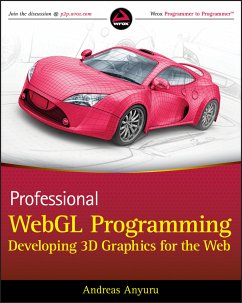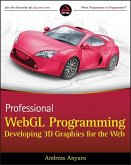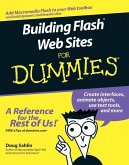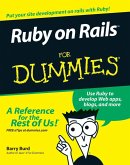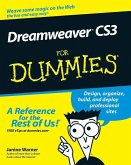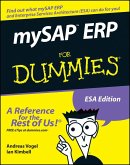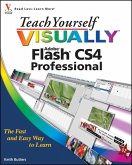

Alle Infos zum eBook verschenken

- Format: PDF
- Merkliste
- Auf die Merkliste
- Bewerten Bewerten
- Teilen
- Produkt teilen
- Produkterinnerung
- Produkterinnerung

Hier können Sie sich einloggen

Bitte loggen Sie sich zunächst in Ihr Kundenkonto ein oder registrieren Sie sich bei bücher.de, um das eBook-Abo tolino select nutzen zu können.
Everything you need to know about developing hardware-accelerated 3D graphics with WebGL! As the newest technology for creating 3D graphics on the web, in both games, applications, and on regular websites, WebGL gives web developers the capability to produce eye-popping graphics. This book teaches you how to use WebGL to create stunning cross-platform apps. The book features several detailed examples that show you how to develop 3D graphics with WebGL, including explanations of code snippets that help you understand the why behind the how. You will also develop a stronger understanding of…mehr
- Geräte: PC
- mit Kopierschutz
- eBook Hilfe
- Größe: 26.24MB
![Professional WebGL Programming (eBook, ePUB) Professional WebGL Programming (eBook, ePUB)]() Andreas AnyuruProfessional WebGL Programming (eBook, ePUB)25,99 €
Andreas AnyuruProfessional WebGL Programming (eBook, ePUB)25,99 €![Building Flash Web Sites For Dummies (eBook, PDF) Building Flash Web Sites For Dummies (eBook, PDF)]() Doug SahlinBuilding Flash Web Sites For Dummies (eBook, PDF)18,99 €
Doug SahlinBuilding Flash Web Sites For Dummies (eBook, PDF)18,99 €![Ruby on Rails For Dummies (eBook, PDF) Ruby on Rails For Dummies (eBook, PDF)]() Barry BurdRuby on Rails For Dummies (eBook, PDF)22,99 €
Barry BurdRuby on Rails For Dummies (eBook, PDF)22,99 €![Dreamweaver CS3 For Dummies (eBook, PDF) Dreamweaver CS3 For Dummies (eBook, PDF)]() Janine WarnerDreamweaver CS3 For Dummies (eBook, PDF)17,99 €
Janine WarnerDreamweaver CS3 For Dummies (eBook, PDF)17,99 €![mySAP ERP For Dummies (eBook, PDF) mySAP ERP For Dummies (eBook, PDF)]() Andreas VogelmySAP ERP For Dummies (eBook, PDF)21,99 €
Andreas VogelmySAP ERP For Dummies (eBook, PDF)21,99 €![Teach Yourself VISUALLY Flash CS4 Professional (eBook, PDF) Teach Yourself VISUALLY Flash CS4 Professional (eBook, PDF)]() Keith ButtersTeach Yourself VISUALLY Flash CS4 Professional (eBook, PDF)27,30 €
Keith ButtersTeach Yourself VISUALLY Flash CS4 Professional (eBook, PDF)27,30 €![Teach Yourself VISUALLY WordPress (eBook, PDF) Teach Yourself VISUALLY WordPress (eBook, PDF)]() George PlumleyTeach Yourself VISUALLY WordPress (eBook, PDF)20,99 €
George PlumleyTeach Yourself VISUALLY WordPress (eBook, PDF)20,99 €-
-
-
Dieser Download kann aus rechtlichen Gründen nur mit Rechnungsadresse in A, B, BG, CY, CZ, D, DK, EW, E, FIN, F, GR, HR, H, IRL, I, LT, L, LR, M, NL, PL, P, R, S, SLO, SK ausgeliefert werden.
- Produktdetails
- Verlag: John Wiley & Sons
- Seitenzahl: 320
- Erscheinungstermin: 23. April 2012
- Englisch
- ISBN-13: 9781119940586
- Artikelnr.: 37340437
- Verlag: John Wiley & Sons
- Seitenzahl: 320
- Erscheinungstermin: 23. April 2012
- Englisch
- ISBN-13: 9781119940586
- Artikelnr.: 37340437
- Herstellerkennzeichnung Die Herstellerinformationen sind derzeit nicht verfügbar.
CHAPTER 1: INTRODUCING WEBGL 1
The Basics of WebGL 1
So Why Is WebGL So Great? 2
Designing a Graphics API 3
An Immediate-Mode API 3
A Retained-Mode API 4
An Overview of Graphics Hardware 4
GPU 5
FrameBuffer 5
Texture Memory 7
Video Controller 7
Understanding the WebGL Graphics Pipeline 7
Vertex Shader 8
Primitive Assembly 12
Rasterization 14
Fragment Shader 14
Per Fragment Operations 17
Comparing WebGL to Other Graphics Technologies 19
OpenGL 19
OpenGL ES 2.0 21
Direct3D 23
HTML5 Canvas 24
Scalable Vector Graphics 28
VRML and X3D 30
Linear Algebra for 3D Graphics 31
Coordinate System 31
Points or Vertices 31
Vectors 32
Dot Product or Scalar Product 33
Cross Product 34
Homogeneous Coordinates 35
Matrices 35
Affine Transformations 38
Summary 44
CHAPTER 2: CREATING BASIC WEBGL EXAMPLES 45
Drawing a Triangle 46
Creating the WebGL Context 49
Creating the Vertex Shader and the Fragment Shader 51
Compiling the Shaders 52
Creating the Program Object and Linking the Shaders 53
Setting Up the Buffers 54
Drawing the Scene 56
Understanding the WebGL Coding Style 57
Debugging Your WebGL Application 58
Using Chrome Developer Tools 58
Using Firebug 65
WebGL Error Handling and Error Codes 67
WebGL Inspector 70
Troubleshooting WebGL 76
Using the DOM API to Load Your Shaders 78
Putting It Together in a Slightly More Advanced Example 80
Experimenting with Code 83
Summary 84
CHAPTER 3: DRAWING 85
WebGL Drawing Primitives and Drawing Methods 86
Primitives 86
Understanding the Importance of Winding Order 91
WebGL's Drawing Methods 93
Typed Arrays 99
Buffer and View 100
Supported View Types 101
Exploring Different Ways to Draw 102
gl.drawArrays() and gl.TRIANGLES 103
gl.drawArrays() and gl.TRIANGLE_STRIP 105
gl.drawElements() and gl.TRIANGLES 106
gl.drawElements() and gl.TRIANGLE_STRIP 108
Conclusions of the Comparison 111
Pre-Transform Vertex Cache and Post-Transform Vertex Cache 111
Interleaving Your Vertex Data for Improved Performance 114
Using an Array of Structures 115
Using a Vertex Array or Constant Vertex Data 123
A Last Example to Wind Things Up 124
Some Things to Experiment With 134
Summary 134
CHAPTER 4: COMPACT JAVASCRIPT LIBRARIES AND TRANSFORMATIONS 137
Working with Matrices and Vectors in JavaScript 138
Sylvester 139
WebGL-mjs 142
glMatrix 146
Using Transformations 150
How Transformations Are Used 150
Understanding the Complete Transformation Pipeline 157
Getting Practical with Transformations 158
Setting Up Buffers with Object Coordinates 159
Creating Transformation Matrices with JavaScript and Uploading Them to the
Shader 160
Uploading the Transformation Matrices to the Vertex Shader in the GPU 161
Calling Your Drawing Methods 162
Understanding the Importance of Transformation Order 162
Using a Grand, Fixed Coordinate System 163
Using a Moving, Local Coordinate System 165
Pushing and Popping Transformation Matrices 167
A Complete Example: Drawing Several Transformed Objects 171
Creating a Cube with WebGL 173
Organization of the View Transformation and the Model Transformation 175
Summary 176
CHAPTER 5: TEXTURING 177
Understanding Lost Context 178
Understanding the Setup Required to Handle Lost Context 179
Factors to Consider When Handling Lost Context 181
Introducing 2D Textures and Cubemap Textures 183
Loading Your Textures 185
Creating a WebGLTexture Object 185
Binding Your Texture 185
Loading the Image Data 186
Uploading the Texture to the GPU 187
Specifying Texture Parameters 189
Understanding the Complete Procedure of Loading a Texture 190
Defi ning Your Texture Coordinates 193
Using Your Textures in Shaders 195
Working with Texture Image Units 197
Working with Texture Filtering 198
Understanding Magnifi cation 199
Understanding Minifi cation 200
Understanding Mipmapping 200
Understanding Texture Coordinate Wrapping 203
Using the gl.REPEAT Wrap Mode 203
Using the gl.MIRRORED_REPEAT Wrap Mode 205
Using the gl.CLAMP_TO_EDGE Wrap Mode 206
A Complete Texture Example 207
Using Images for Your Textures 210
Downloading Free Textures 210
Basing Textures on Your Own Photos 211
Drawing Images 211
Buying Textures 211
Understanding Same-Origin Policy and Cross-Origin Resource Sharing 212
Understanding Same-Origin Policy for Images in General 212
Understanding Same-Origin Policy for Textures 214
Understanding Cross-Origin Resource Sharing 215
Summary 217
CHAPTER 6: ANIMATIONS AND USER INPUT 219
Animating the Scene 219
Using setInterval() and setTimeout() 221
Using requestAnimationFrame() 222
Compensating Movement for Different Frame Rates 225
Creating an FPS Counter to Measure the Smoothness of Your Animation 226
Understanding the Disadvantages of Using FPS as a Measurement 228
Event Handling for User Interaction 230
Basic Event Handling with DOM Level 0 231
Advanced Event Handling with DOM Level 2 232
Key Input 234
Mouse Input 239
Applying Your New Knowledge 240
Summary 246
CHAPTER 7: LIGHTING 249
Understanding Light 249
Working with a Local Lighting Model 250
Understanding the Phong Reflection Model 251
Ambient Reflection 252
Diff use Reflection 253
Specular Reflection 255
Understanding the Complete Equation and Shaders for the Phong Reflection
Model 259
Using Lighting with Texturing 263
Understanding the JavaScript Code Needed for WebGL Lighting 267
Setting Up Buffers with Vertex Normals 268
Calculating and Uploading the Normal Matrix to the Shader 270
Uploading the Light Information to the Shader 270
Using Different Interpolation Techniques for Shading 271
Flat Shading 272
Gouraud Shading 273
Phong Shading 274
Understanding the Vectors That Must Be Normalized 278
Normalization in the Vertex Shader 278
Normalization in the Fragment Shader 279
Using Different Types of Lights 279
Directional Lights 280
Point Lights 280
Spot Lights 281
Understanding the Attenuation of Light 284
Understanding Light Mapping 288
Summary 289
CHAPTER 8: WEBGL PERFORMANCE OPTIMIZATIONS 291
WebGL under the Hood 292
Hardware that Powers WebGL 292
Key Software Components 294
WebGL Performance Optimizations 296
Avoiding a Typical Beginner's Mistake 296
Locating the Bottleneck 298
General Performance Advice 302
Performance Advice for CPU-Limited WebGL 305
Performance Advice for Vertex-Limited WebGL 307
Performance Advice for Pixel-Limited WebGL 308
A Closer Look at Blending 310
Introducing Blending 310
Setting the Blending Functions 311
Understanding Drawing Order and the Depth Buffer 314
Drawing a Scene with Both Opaque and Semi-Transparent Objects 315
Changing the Default Operator for the Blend Equation 315
Using Premultiplied Alpha 316
Taking WebGL Further 317
Using WebGL Frameworks 317
Publishing to the Google Chrome Web Store 318
Using Additional Resources 318
Summary 319
Index 321
CHAPTER 1: INTRODUCING WEBGL 1
The Basics of WebGL 1
So Why Is WebGL So Great? 2
Designing a Graphics API 3
An Immediate-Mode API 3
A Retained-Mode API 4
An Overview of Graphics Hardware 4
GPU 5
FrameBuffer 5
Texture Memory 7
Video Controller 7
Understanding the WebGL Graphics Pipeline 7
Vertex Shader 8
Primitive Assembly 12
Rasterization 14
Fragment Shader 14
Per Fragment Operations 17
Comparing WebGL to Other Graphics Technologies 19
OpenGL 19
OpenGL ES 2.0 21
Direct3D 23
HTML5 Canvas 24
Scalable Vector Graphics 28
VRML and X3D 30
Linear Algebra for 3D Graphics 31
Coordinate System 31
Points or Vertices 31
Vectors 32
Dot Product or Scalar Product 33
Cross Product 34
Homogeneous Coordinates 35
Matrices 35
Affine Transformations 38
Summary 44
CHAPTER 2: CREATING BASIC WEBGL EXAMPLES 45
Drawing a Triangle 46
Creating the WebGL Context 49
Creating the Vertex Shader and the Fragment Shader 51
Compiling the Shaders 52
Creating the Program Object and Linking the Shaders 53
Setting Up the Buffers 54
Drawing the Scene 56
Understanding the WebGL Coding Style 57
Debugging Your WebGL Application 58
Using Chrome Developer Tools 58
Using Firebug 65
WebGL Error Handling and Error Codes 67
WebGL Inspector 70
Troubleshooting WebGL 76
Using the DOM API to Load Your Shaders 78
Putting It Together in a Slightly More Advanced Example 80
Experimenting with Code 83
Summary 84
CHAPTER 3: DRAWING 85
WebGL Drawing Primitives and Drawing Methods 86
Primitives 86
Understanding the Importance of Winding Order 91
WebGL's Drawing Methods 93
Typed Arrays 99
Buffer and View 100
Supported View Types 101
Exploring Different Ways to Draw 102
gl.drawArrays() and gl.TRIANGLES 103
gl.drawArrays() and gl.TRIANGLE_STRIP 105
gl.drawElements() and gl.TRIANGLES 106
gl.drawElements() and gl.TRIANGLE_STRIP 108
Conclusions of the Comparison 111
Pre-Transform Vertex Cache and Post-Transform Vertex Cache 111
Interleaving Your Vertex Data for Improved Performance 114
Using an Array of Structures 115
Using a Vertex Array or Constant Vertex Data 123
A Last Example to Wind Things Up 124
Some Things to Experiment With 134
Summary 134
CHAPTER 4: COMPACT JAVASCRIPT LIBRARIES AND TRANSFORMATIONS 137
Working with Matrices and Vectors in JavaScript 138
Sylvester 139
WebGL-mjs 142
glMatrix 146
Using Transformations 150
How Transformations Are Used 150
Understanding the Complete Transformation Pipeline 157
Getting Practical with Transformations 158
Setting Up Buffers with Object Coordinates 159
Creating Transformation Matrices with JavaScript and Uploading Them to the
Shader 160
Uploading the Transformation Matrices to the Vertex Shader in the GPU 161
Calling Your Drawing Methods 162
Understanding the Importance of Transformation Order 162
Using a Grand, Fixed Coordinate System 163
Using a Moving, Local Coordinate System 165
Pushing and Popping Transformation Matrices 167
A Complete Example: Drawing Several Transformed Objects 171
Creating a Cube with WebGL 173
Organization of the View Transformation and the Model Transformation 175
Summary 176
CHAPTER 5: TEXTURING 177
Understanding Lost Context 178
Understanding the Setup Required to Handle Lost Context 179
Factors to Consider When Handling Lost Context 181
Introducing 2D Textures and Cubemap Textures 183
Loading Your Textures 185
Creating a WebGLTexture Object 185
Binding Your Texture 185
Loading the Image Data 186
Uploading the Texture to the GPU 187
Specifying Texture Parameters 189
Understanding the Complete Procedure of Loading a Texture 190
Defi ning Your Texture Coordinates 193
Using Your Textures in Shaders 195
Working with Texture Image Units 197
Working with Texture Filtering 198
Understanding Magnifi cation 199
Understanding Minifi cation 200
Understanding Mipmapping 200
Understanding Texture Coordinate Wrapping 203
Using the gl.REPEAT Wrap Mode 203
Using the gl.MIRRORED_REPEAT Wrap Mode 205
Using the gl.CLAMP_TO_EDGE Wrap Mode 206
A Complete Texture Example 207
Using Images for Your Textures 210
Downloading Free Textures 210
Basing Textures on Your Own Photos 211
Drawing Images 211
Buying Textures 211
Understanding Same-Origin Policy and Cross-Origin Resource Sharing 212
Understanding Same-Origin Policy for Images in General 212
Understanding Same-Origin Policy for Textures 214
Understanding Cross-Origin Resource Sharing 215
Summary 217
CHAPTER 6: ANIMATIONS AND USER INPUT 219
Animating the Scene 219
Using setInterval() and setTimeout() 221
Using requestAnimationFrame() 222
Compensating Movement for Different Frame Rates 225
Creating an FPS Counter to Measure the Smoothness of Your Animation 226
Understanding the Disadvantages of Using FPS as a Measurement 228
Event Handling for User Interaction 230
Basic Event Handling with DOM Level 0 231
Advanced Event Handling with DOM Level 2 232
Key Input 234
Mouse Input 239
Applying Your New Knowledge 240
Summary 246
CHAPTER 7: LIGHTING 249
Understanding Light 249
Working with a Local Lighting Model 250
Understanding the Phong Reflection Model 251
Ambient Reflection 252
Diff use Reflection 253
Specular Reflection 255
Understanding the Complete Equation and Shaders for the Phong Reflection
Model 259
Using Lighting with Texturing 263
Understanding the JavaScript Code Needed for WebGL Lighting 267
Setting Up Buffers with Vertex Normals 268
Calculating and Uploading the Normal Matrix to the Shader 270
Uploading the Light Information to the Shader 270
Using Different Interpolation Techniques for Shading 271
Flat Shading 272
Gouraud Shading 273
Phong Shading 274
Understanding the Vectors That Must Be Normalized 278
Normalization in the Vertex Shader 278
Normalization in the Fragment Shader 279
Using Different Types of Lights 279
Directional Lights 280
Point Lights 280
Spot Lights 281
Understanding the Attenuation of Light 284
Understanding Light Mapping 288
Summary 289
CHAPTER 8: WEBGL PERFORMANCE OPTIMIZATIONS 291
WebGL under the Hood 292
Hardware that Powers WebGL 292
Key Software Components 294
WebGL Performance Optimizations 296
Avoiding a Typical Beginner's Mistake 296
Locating the Bottleneck 298
General Performance Advice 302
Performance Advice for CPU-Limited WebGL 305
Performance Advice for Vertex-Limited WebGL 307
Performance Advice for Pixel-Limited WebGL 308
A Closer Look at Blending 310
Introducing Blending 310
Setting the Blending Functions 311
Understanding Drawing Order and the Depth Buffer 314
Drawing a Scene with Both Opaque and Semi-Transparent Objects 315
Changing the Default Operator for the Blend Equation 315
Using Premultiplied Alpha 316
Taking WebGL Further 317
Using WebGL Frameworks 317
Publishing to the Google Chrome Web Store 318
Using Additional Resources 318
Summary 319
Index 321
